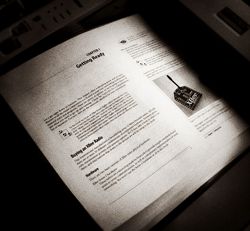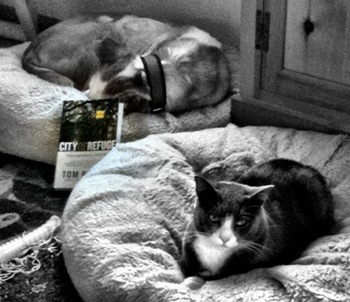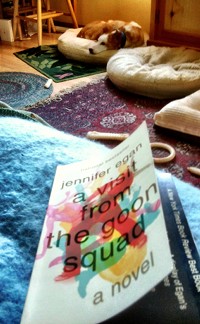
I recently purchased Building Wireless Sensor Networks in electronic form. O’Reilly offered it for download in several electronic formats, including ePub (for my iPhone) and PDF formats. After looking at the content, I decided I wanted to print out the first couple chapters to make it easier to work with the devices without having to continually fiddle around with my phone.
I used the following commands. psresize enlarges each page, in this case by 20%, and pstops is used to move the right-side page to the left by an inch. For the cover page, and other full-bleed content, this will cause the right-side page to overlap the left, but because of the margins around the text block throughout the majority of the book, this overlap doesn’t matter and it allows us to make the text bigger when it’s printed two pages per side.
$ pdftops Building_Wireless_Sensor_Networks.pdf
$ cat Building_Wireless_Sensor_Networks.ps \
| psresize -W8.5in -H11in -w10.20in -h13.20in \
| pstops "2:0(0,0),1(-72,0)" \
| psnup -2 > wireless_networks_nup.ps
$ ps2pdf wireless_networks_nup.ps
To print, choose double-sided, flip on short edge.
I’m trying out a standing desk at work and I discovered that when I went to my blog (and our internal wiki) that for some reason, Chrome on the laptop I’m using wasn’t displaying monospace fonts the way I expected. In Chrome’s preferences I could set the font size for all the other fonts, but it only let me choose the monospace font, not it’s default size. I’d never noticed this before.
A quick Internet search revealed this very helpful page: http://meyerweb.com/eric/thoughts/2010/02/12/fixed-monospace-sizing/
It turns out that monospace sizing is a common problem, and even worse, how they’re sized is browser dependent. The hack is to define the tt, pre, and code elements in your CSS as follows:
1 2 3 4 | pre, tt, code { font-family: monospace, sans-serif; font-size: 1em; } |
It seems wrong to have monospace and then sans-serif, but including sans-serif (or any other font-family category besides monospace) causes browsers to respect the following font-size declaration. Without it, the browser assumes that the 1em sizing is relative to the default monospace font size (which is too large and unchangable) rather than relative to the size of the rest of the content on the page.
Anyway, it works. For now.
Update: Actually, it doesn't work. Firefox, Safari and Chrome on a Mac let you choose the monospace font size, and tweak it until it matches the body text size. When this hack is applied, the monospace fonts become the same size as the body font, which is typically too large.
In late August 2005, Hurricane Katrina struck New Orleans, destroying the levees designed to protect the city, flooding 80% of it, and killing 1,464 people. City of Refuge, written by the author of Why New Orleans Matters and a resident of the city, is a fictional retelling of the disaster and it’s aftermath. It’s an emotional story, well written, and does a good job of making New Orleans and the devastation of Katrina real. Read next to Dave Egger’s Zeitoun, it’s hard to imagine how the maintenance of the levees, emergency response, and relief efforts could have been worse. Thankfully, book mostly stays clear from making political arguments or assigning blame, focusing mainly on how two different families cope with the destruction of the city they lived in.
I enjoyed it—learning more about the disaster and the rhythms and flavor of the city itself—but I wouldn’t recommend it except for readers interested in another perspective on Katrina.
A month ago, we noticed that our pump was coming on when we weren’t using any water. We immediately suspected the toilet because there was no evidence of water anywhere (on the floor, leaking under the house, etc.), but when we shut off the water supply to the toilet before going to bed, the tank was still full of water in the morning. The gaskets in our kitchen faucet were starting to fail, and it was occasionally leaking down the stem of the faucet, so we replaced the cartridge hoping this would solve our water problem. The faucet works a lot better, but we were still losing water.
We tried turning off the pump at night to confirm we really were losing water, and when we got up in the morning, we had no pressure. The combination of turning off the pump and the toilet supply resulted in no loss in pressure, so the leak was somewhere in the toilet after all. It wasn’t the flapper valve (or the tank would be empty in the morning), and we didn’t see any drips or leaks, so the supply must have been leaking into the top tank somewhere under the water and draining into the bowl where we didn’t notice it.
The obvious fix for this is to replace the stuff in the tank. But the toilet didn’t really work very well anyway, and used the full 1.6 gallons per flush. Andrea installed a dual flush kit that was supposed to use less water for liquid waste, but it didn’t work: the lower “number one” button didn’t release enough water into the bowl for it to actually flush. 1.6 gallons of water doesn’t sound like much, but we’re currently paying 10 cents a gallon for water, so we’re spending more than a dollar a day just to flush the toilet. We have an outhouse, but because we’re so close to Goldstream Creek, it can’t be in the ground and needs to be pumped out whenever it gets full. So our best option was to replace the leaking toilet with something that won’t leak, and uses less than the standard 1.6 gallons of water per flush.
The two current strategies to lowering water consumption in a toilet are to make the top tank smaller so less water is used for every flush, or to implement a dual flush setup where a small amount of water is used for liquids and the full volume flushes solids. Consumer Reports doesn’t give the dual flush models very high ratings, mostly because the bowl isn’t rinsed as well when so little water is used. As a result, we decided to get a toilet that uses a smaller top tank (1.28 gallons per flush). The highest rated model by Consumer Reports is an American Standard one-piece “Cadet 3,” but the local plumbing place and the box stores didn’t have that model in stock. Getting one shipped to Alaska would have taken more than two months. The next place models were the two-piece version of the Cadet 3 and the Kohler Cimarron. Consumer Reports gave the Cimarron slightly higher marks overall, with better bowl cleaning but worse solid waste elimination ratings. While we were in the store, we went to the web site for the company that rates toilets for solid waste elimination (www.map-testing.com) and consulted the latest ratings (from April 4th (!)). The Cimarron was better rated for this statistic (1,000 vs. 800), so that’s what we got.
Installation went smoothly. Thus far, we’re satisfied. What is surprising about the toilet is how fast it flushes. It empties the top tank into the bowl in less than a second, and the bowl empties almost immediately after that. It seems that the strategy is to dump almost all of the top tank water into the bowl as quickly as possible to eliminate waste, and use the small amount remaining to wash down the bowl. So far so good! We’re saving more than three cents each time we flush, and hopefully we will have many fewer double (and more…) flush events.
After my disappointment that Skippy Dies was eliminated from The Morning News Tournament of Books, I decided I should read the book that beat it, and which eventually won in the final round by a one-vote margin, Jennifer Egan’s A Visit From the Goon Squad, just out in paperback. After beating Skippy, Goon Squad was beaten by Franzen’s heavyweight, but came back in the zombie round and eventually met Freedom (again) in the finals.
Some of the comments from judges choosing Goon Squad:
- Sarah Manguso: Franzen made me weep for lost love, but Egan reminded me that death is coming.
- Jennifer Weiner: Egan gets my vote, because if Franzen takes the prize, then the terrorists win (and because even if he doesn’t, you know the Los Angeles Times will run his picture anyhow).
- Anthony Doerr: Which of these two books might help, to borrow Zadie’s Smith’s clause, “shake the novel out of its present complacency?” Egan’s.
- Michele Filgate: There’s no comparison. Egan’s novel is innovative and playful, while simultaneously smart and captivating.
- Andrew Womack: For me, this decision comes down to pacing, and Franzen is the Pink Floyd to Egan’s Sex Pistols; by the end of Freedom I couldn’t take another meandering guitar solo, while I was dazzled by how much Goon Squad packed into such a compact space.
Jennifer Egan (on hearing she won):
- A rooster will fit perfectly into our Brooklyn landscape…our sons will be thrilled; our two cats, even more so.
I just finished it, and I was blown away. I wasn’t expecting to like it much: a “novel” of connected short stories, ho hum. An entire chapter done using a piece of software implicated in the 2003 Columbia shuttle disaster (PowerPoint), yetch. But the way the stories weave through time and from one character’s viewpoint to another, never so obvious as to touch the same scene twice, but covering such a wide swath of time was amazing. For me, it wasn’t until the last chapter, which takes place at some point in the 2020’s, that the collective effective of the stories really came together into a very real feeling for the things we gain and (mostly) lose in our lives; the way our decisions combine to make a life.
The final contest in the Tournament really was a fitting one—both Egan and Franzen are attempting to describe modern life in America (as cliché as that sounds). Franzen does this by filling his book with the full lives of his three main characters. Egan does it by sprinkling her chapters with short bursts from a wide range of related characters, varying perspective, time, age, and narrative style in each. The challenge for Franzen is how to tell the full story of three people without the reader growing sick of them. The challenge for Egan is getting us to actually care about the characters in the short time we spend with them, or at the very least be willing to listen to what they have to say.
She succeeds, spectacularly.


